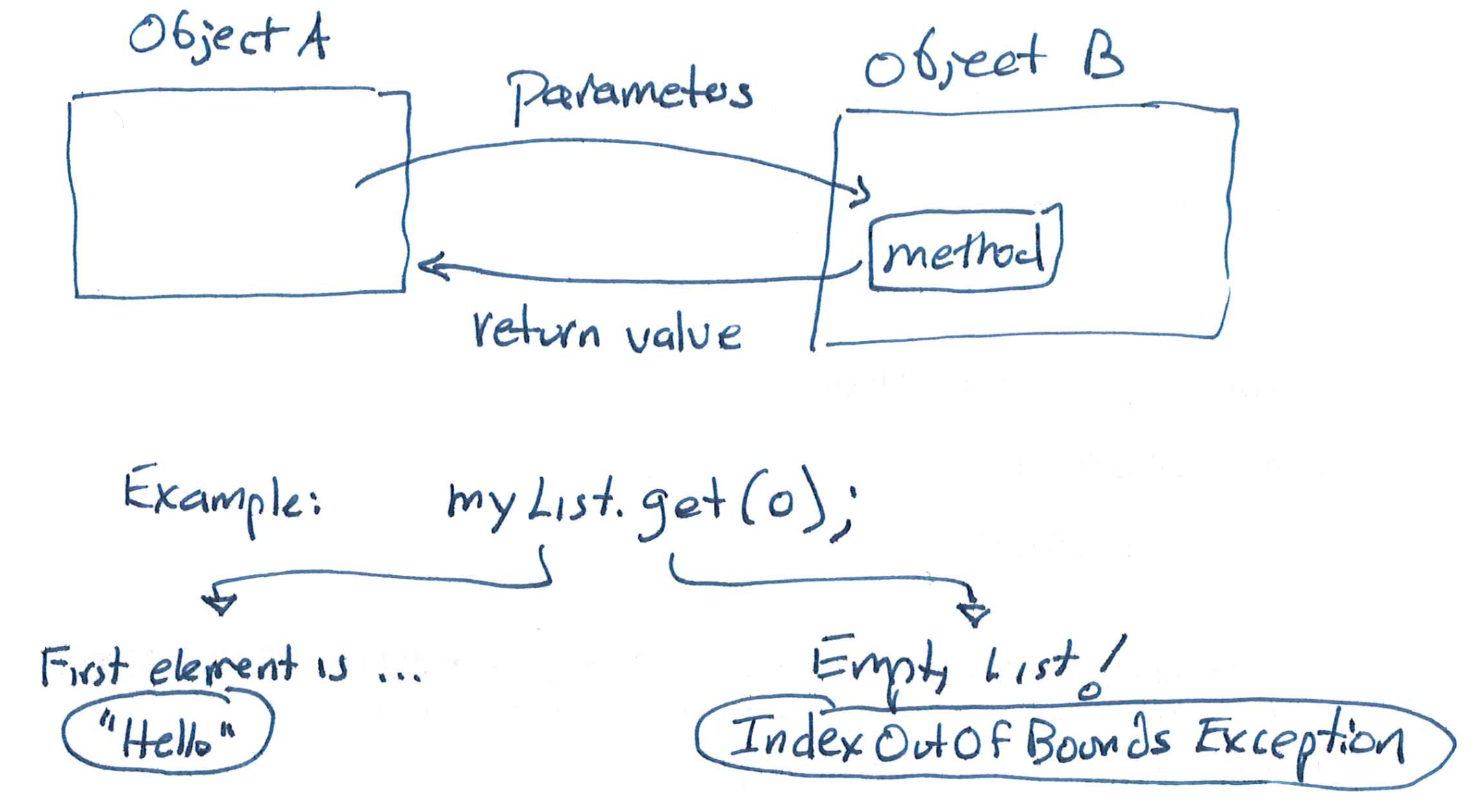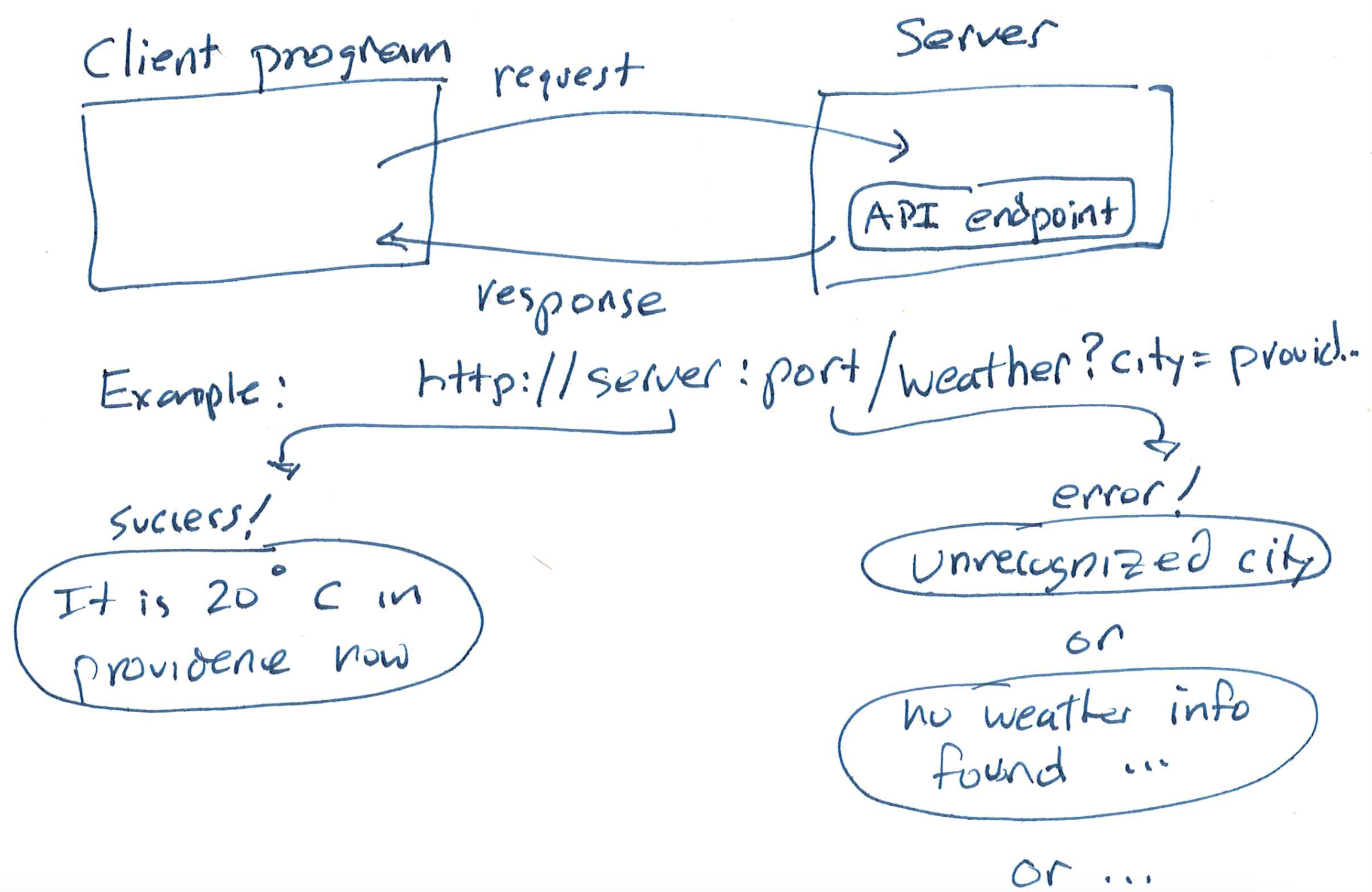Web APIs and Integration Testing with Mocks
This chapter combines some notes from Fall 2025 and Spring 2025. As such, it will have examples in both TypeScript and in Java.
Web APIs
There's a lot of useful information out there on the web. One way we might work with that info is to scrape websites: write a script that interacts with the HTML on a webpage to extract the info.
Why Not Web Scraping?
What are some weaknesses of web scraping, from the perspective of both the person doing the scraping, and the person who is running the website?
Think, then click!
A few issues might be:
- The owner of the data might want to charge for access in a fine-grained way, or limit access differently from the way it works on a webpage.
- Web scraping is unstable. If a site's format changes, web-scraper scripts can break. APIs can have breaking changes too, but when they do, the changes usually come with a warning to users!
- Web scraping is mostly a one-sided effort. While a site designer might work to ease the job of web scrapers, details can still require some guesswork on the part of the script author.
It turns out that ideas from web-scraping will remain useful though, when we get to testing front-end applications in a few weeks.
Web APIs
APIs work like this: the user sends a structured request to the API, which replies in a documented, structured way. API is short for Application Programming Interface, and often you'll hear the set of functions it provides to users called the "interface".
This is an example of an "interface" in the broad, classical sense. It isn't a Java interface. It's one of many ways for two programs to communicate across the web, but it's specific and well-defined.
APIs are everywhere. Whenever you log in via Google (even on a non-Google site) you're using Google's Authentication API.
APIs are very like method calls! The pictures are very similar:


The differences are in the ways we go about making a call (and processing the result). E.g., we have to build a request string that embodies the call, and we have to turn the response object into usable data.
Example: National Weather Service
Let's start right away with a serious, high-volume API: the U.S. National Weather Service. These APIs tend to be well-documented. We'll use the NWS because, while many professional APIs require registration and the use of an API key to use them, the NWS API is free and requires no registration.
The NWS API is not the exact API you will be using on the sprint, but I like it for demonstrating the same kind of interaction you'll need to implement.
Let's get weather information for Providence. Our geocordinates here are: 41.826820, -71.402931. According to the docs, we can start by sending a points query with these coordinates: https://api.weather.gov/points/41.8268,-71.4029:
Queries
There are a few things to notice right away. First, the URL we sent had a host portion (https://api.weather.gov) and an endpoint (called, confusingly, points) that represents the kind of query we're asking. Then there are parameters to the query (41.8268,-71.4029).
Because last year, the API would give an error if we tried to provide 6 significant digits. So we truncate.
Responses
We get this back:
{
"@context": [
"https://geojson.org/geojson-ld/geojson-context.jsonld",
{
"@version": "1.1",
"wx": "https://api.weather.gov/ontology#",
"s": "https://schema.org/",
"geo": "http://www.opengis.net/ont/geosparql#",
"unit": "http://codes.wmo.int/common/unit/",
"@vocab": "https://api.weather.gov/ontology#",
"geometry": {
"@id": "s:GeoCoordinates",
"@type": "geo:wktLiteral"
},
"city": "s:addressLocality",
"state": "s:addressRegion",
"distance": {
"@id": "s:Distance",
"@type": "s:QuantitativeValue"
},
"bearing": {
"@type": "s:QuantitativeValue"
},
"value": {
"@id": "s:value"
},
"unitCode": {
"@id": "s:unitCode",
"@type": "@id"
},
"forecastOffice": {
"@type": "@id"
},
"forecastGridData": {
"@type": "@id"
},
"publicZone": {
"@type": "@id"
},
"county": {
"@type": "@id"
}
}
],
"id": "https://api.weather.gov/points/41.8268,-71.4029",
"type": "Feature",
"geometry": {
"type": "Point",
"coordinates": [
-71.402900000000002,
41.826799999999999
]
},
"properties": {
"@id": "https://api.weather.gov/points/41.8268,-71.4029",
"@type": "wx:Point",
"cwa": "BOX",
"forecastOffice": "https://api.weather.gov/offices/BOX",
"gridId": "BOX",
"gridX": 64,
"gridY": 64,
"forecast": "https://api.weather.gov/gridpoints/BOX/64,64/forecast",
"forecastHourly": "https://api.weather.gov/gridpoints/BOX/64,64/forecast/hourly",
"forecastGridData": "https://api.weather.gov/gridpoints/BOX/64,64",
"observationStations": "https://api.weather.gov/gridpoints/BOX/64,64/stations",
"relativeLocation": {
"type": "Feature",
"geometry": {
"type": "Point",
"coordinates": [
-71.418784000000002,
41.823056000000001
]
},
"properties": {
"city": "Providence",
"state": "RI",
"distance": {
"unitCode": "wmoUnit:m",
"value": 1380.4369590568999
},
"bearing": {
"unitCode": "wmoUnit:degree_(angle)",
"value": 72
}
}
},
"forecastZone": "https://api.weather.gov/zones/forecast/RIZ002",
"county": "https://api.weather.gov/zones/county/RIC007",
"fireWeatherZone": "https://api.weather.gov/zones/fire/RIZ002",
"timeZone": "America/New_York",
"radarStation": "KBOX"
}
}
This wasn't nicely formatted for human reading. Why? Because it's meant for programs to consume. This string should bear a remarkable resemblance to TypeScript objects. It's called Json: JavaScript Object Notation. When we write programs that work with web APIs, we'll never manually parse these, we'll use a library that does it for us. In general:
- when we're converting data or an object in our program to a format meant for transmission (like Json) we'll call it serialization; and
- when we're converting a transmission format (like Json) into data or an object in our program, we'll call it deserialization.
What else do you notice about this data?
Think, then click!
One thing is: you can ignore a lot of it. This first query gives us useful information for further uses of the API. Another is that there's no actual weather information here...
See the documentation to understand the meaning of specific fields in the response. At a high level, this query tells us which NWS grid location Providence is in, along with telling us URLs for common queries about that grid location. The NWS API needs you to work with it in stages.
Building API Servers
We've provided a number of examples of setting up an API server. Whether we're doing this in Java or TypeScript, the flow of our proxy server for weather will look roughly like this:
- When our server starts up, it listens for requests on a set of endpoints. We need to register an endpoint (for callers to make weather requests) and a handler callback for the server to call when it gets a request.
- When someone sends our API server a request for the weather, it passes the request to the handler we gave it.
- The handler sends a request of its own to the NWS, asking what their grid coordinates are for the geo-location given.
- The handler sends a second request to the NWS for the forecast at that location.
- Once the forecast is received, the handler assembles a JSON response and sends it back to the original caller—reporting the weather forecast.
You can see a much-simplified version of this loop in my example Providence Weather app. The source code is (here).
This was one of the first things I built with Copilot over the summer, as I was working on the course. The README file in the repo has some notes about how it went. Copilot was great for building the initial prototype, but had some trouble with the structure of the JSON it needed to process and adding TypeScript types.
Testing API Servers: Example of Integration Testing
Our philosophy is generally that you'll be able to test most everything you do. So: how can I test my API server?
One way is to write unit tests. E.g., if we have a CSV data source (hint: you do!), we should have unit tests for that. If we have a source that goes to the National Weather Service to fetch forecasts, we should test that.
But neither of those will test the handlers, or anything between the handler and the data source. We need to test the combination of a number of units: the code that accesses the data source, code (if any) that processes the raw data, the API handlers of our server, etc. When you're testing the integration of multiple components in your application (such as our server tests) this is called integration testing.
The gearups contain examples of how to set this up. In brief, you start up the server and send "fake" API queries as part of each of your test cases. Then each test looks at the responses and decides whether they are good or bad.
Mocking (a remarkably powerful technique)
Consider what happens when I run integration tests. These generate web requests to our server, and then (assuming normal operation), our server will send a series of web requests to the NWS API. This is reasonable, but has a number of problems. What issues have I introduced into my testing because running the tests requires the NWS API?
Think, then click!
At the very least, the more I test (and I should test often!), the more I'll be spamming the NWS with requests. If I do it too much, they might think I am running a denial-of-service attack on them, and rate limit my requests. I also just can't run my test suite without an Internet connection, or if the NWS is down for maintenance.
(There are other reasons, too.)
You'll use mocking in every sprint from now until the class is over; we've only barely discovered how important it is as a technique. And the patterns we have learned so far are perfect for implementing mocking well. To start with, a data source can be a strategy provided by the caller (real or mock).
The Mocking example from the live code shows one way to do this. You can also use Jest or Playwright themselves to mock certain functionality like input and output.
A more conceptual example can demonstrate generally useful ideas like dependency injection without tying them to how those ideas are used by a specific library. In particular, notice how dependency injection here is just passing an argument to a factory function.